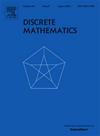A note on the multicolour version of the Erdős-Hajnal conjecture
IF 0.7
3区 数学
Q2 MATHEMATICS
引用次数: 0
Abstract
Informally, the multicolour version of the Erdős-Hajnal conjecture (shortly EH-conjecture) asserts that if a sufficiently large host clique on n vertices is edge-coloured avoiding a copy of some fixed edge-coloured clique, then there is a large homogeneous set of size for some positive β, where a set of vertices is homogeneous if it does not induce all the colours. This conjecture, if true, claims that imposing local conditions on edge-partitions of cliques results in a global structural consequence such as a large homogeneous set, a set avoiding all edges of some part. While this conjecture attracted a lot of attention, it is still open even for two colours.
In this note, we reduce the multicolour version of the EH-conjecture to the case when the number of colours used in a host clique is either the same as in the forbidden pattern or one more. We exhibit a non-monotonicity behaviour of homogeneous sets in coloured cliques with forbidden patterns by showing that allowing an extra colour in the host graph could actually decrease the size of a largest homogeneous set.
关于Erdős-Hajnal猜想的多色版本的注释
非正式地,Erdős-Hajnal猜想的多色版本(简称eh猜想)断言,如果n个顶点上的足够大的主团是边色的,避免了某些固定边色团的副本,那么对于某些正β,存在一个大小为nβ的大齐次集合,其中一组顶点如果不诱导所有颜色则是齐次的。这个猜想,如果成立,声称对派系的边划分施加局部条件会导致全局结构结果,例如一个大的齐次集合,一个避免某些部分的所有边的集合。虽然这个猜想吸引了很多人的注意,但即使是两种颜色,它仍然是开放的。在本文中,我们将eh猜想的多色版本简化为主团中使用的颜色数量与禁止图案中使用的颜色数量相同或多一个的情况。通过在主图中允许一个额外的颜色实际上可以减小最大齐次集的大小,我们展示了具有禁止模式的彩色团中的齐次集的非单调性行为。
本文章由计算机程序翻译,如有差异,请以英文原文为准。
求助全文
约1分钟内获得全文
求助全文
来源期刊

Discrete Mathematics
数学-数学
CiteScore
1.50
自引率
12.50%
发文量
424
审稿时长
6 months
期刊介绍:
Discrete Mathematics provides a common forum for significant research in many areas of discrete mathematics and combinatorics. Among the fields covered by Discrete Mathematics are graph and hypergraph theory, enumeration, coding theory, block designs, the combinatorics of partially ordered sets, extremal set theory, matroid theory, algebraic combinatorics, discrete geometry, matrices, and discrete probability theory.
Items in the journal include research articles (Contributions or Notes, depending on length) and survey/expository articles (Perspectives). Efforts are made to process the submission of Notes (short articles) quickly. The Perspectives section features expository articles accessible to a broad audience that cast new light or present unifying points of view on well-known or insufficiently-known topics.
 求助内容:
求助内容: 应助结果提醒方式:
应助结果提醒方式:


